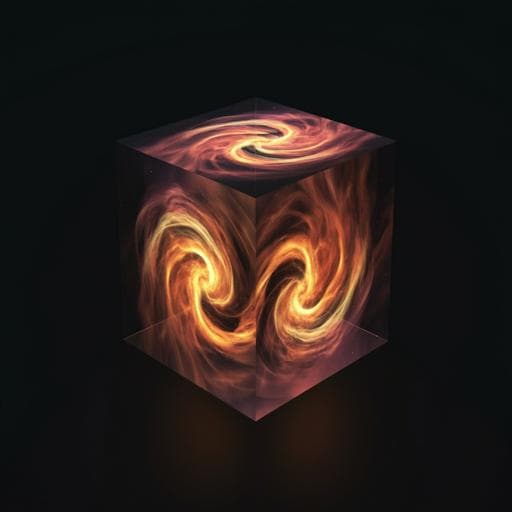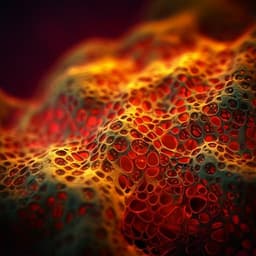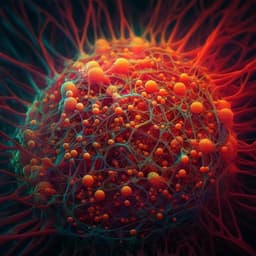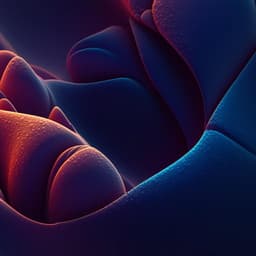
Physics
3D stochastic interferometer detects picometer deformations and minute dielectric fluctuations of its optical volume
G. Graciani, M. Filoche, et al.
Discover the groundbreaking 3D stochastic interferometer developed by Guillaume Graciani, Marcel Filoche, and François Amblard, which detects picometer-scale deformations and dielectric fluctuations with unmatched sensitivity. This innovative approach outshines conventional light scattering techniques by a factor of 100.
~3 min • Beginner • English
Introduction
The study addresses the limits of optical interferometry for detecting extremely small changes in optical path length or wavelength, traditionally achieved with highly ordered interferometers (e.g., Michelson, Fabry–Pérot, LIGO/VIRGO). Speckle metrology leverages disordered coherent light to obtain sensitive measurements but typically relies on time-domain imaging of speckle patterns, restricting accessible frequencies to the camera acquisition rate. The authors propose a frequency-domain method that measures intensity fluctuations of a single speckle grain within a diffuse reflective cavity. The cavity forms a statistically isotropic and homogeneous 3D random (Berry) field that is ergodically sensitive to perturbations of the optical volume (geometry and dielectric tensor). The goal is to demonstrate picometer-level sensitivity to cavity deformations and minute dielectric fluctuations, with broadband frequency response across 8–10 decades up to 100 MHz, and to compare performance against conventional dynamic light scattering techniques.
Literature Review
Background highlights: Classical interferometers demand precise field geometries to achieve extreme sensitivities (historical examples from Fizeau to gravitational wave detection). Speckle-based metrology has been used for wavelength determination, spectral analysis, displacement/angle metrology, and refractive index sensing, with sensitivities approaching ordered-light interferometers. Existing speckle methods analyze time-domain speckle images and are limited by image acquisition rates; some recent work explores sensitivity to wavelength changes in integrating spheres. Theoretical foundations include 3D random wave (Berry) fields and known mean chord length invariance in scattering media. The present work extends these ideas by implementing a 3D stochastic interferometer that uses frequency-domain analysis and integrates over random 3D paths to sense global optical volume fluctuations, aiming to surpass the bandwidth and sensitivity limits of prior speckle metrology and classical DLS/DWS.
Methodology
Experimental setup: A single-frequency CW laser (λ ≈ 660 nm, linewidth ≤ 1 MHz, coherence length ≈ 95 m) is injected by multimode fiber into a closed, centimeter-scale cylindrical cavity made from compressed quartz powder with near-unity Lambertian reflectivity (albedo ≈ 0.9994). The cavity exhibits a small reflection loss ε ≈ 0.5 × 10−4, geometric gain G ≈ 1700, and finesse F ≈ 10500. The cavity produces a fully developed 3D random (Berry) field composed of many mutually coherent plane-wave components with isotropic wavevectors, random phases, and uniformly distributed polarizations. The photon residence time and path-length statistics are characterized by injecting 120 ps laser pulses and recording the temporal response (TCSPC), yielding average residence time τ ≈ 207 ns and average photon path length Λ ≈ 62 m. Measurement: Speckle intensity at a point P is collected by a single-mode fiber inside the cavity, split to two APDs, and cross-correlated by a multi-tau digital correlator to obtain g(2)(τ), normalized to g(1)(τ). A baseline measurement in an unperturbed cavity (air, stabilized environment) is recorded to quantify instrumental decorrelation and its noise standard deviation versus τ. The detection metric for perturbations is the excess decorrelation relative to this baseline. Environmental controls include thermal, acoustic, and electromagnetic isolation and vibration damping. Cavity deformation experiments: The cavity is split into two halves with two 1 mm-thick piezoelectric actuators inserted 120° apart. A sinusoidal voltage at 1 kHz modulates separation, deforming the cavity. The resulting intensity decorrelation modulation is measured versus drive amplitude. Dielectric fluctuation experiments: Samples are introduced into the cavity. (1) Jammed emulsion of PDMS oil-in-water with droplet radius ≈ 459 nm at high volume fraction (jammed), producing multiple scattering with transport mean free path ≈ 0.25 mm. (2) PMMA microspheres (20 μm diameter) in water at different volume fractions to span single to multiple scattering regimes. Correlator settings provide lag times from 12.5 ns up to thousands of seconds, enabling frequency coverage up to ~100 MHz. Data processing includes normalization by the coherence factor β, baseline subtraction to compute excess decorrelation δ(τ), and representation on log scales with noise floors to assess SNR. Additional considerations: The measurement intrinsically perturbs the 3D field due to fiber sampling (loss of spherical symmetry and 3D-to-2D projection). The effective albedo and gain are re-calibrated when samples or collection optics are present. Noise sources include laser gain relaxation (~2 kHz), digitization (triangular averaging), and long-term laser wavelength drift, mitigated by optimizing acquisition time and laser stability.
Key Findings
- Broadband frequency-domain sensing: The method measures decorrelation spectra across 8–10 frequency decades up to ~100 MHz using a single speckle grain intensity trace.
- Cavity properties: Reflection loss ε ≈ 0.5 × 10−4; geometric gain G ≈ 1700; finesse F ≈ 10500; average photon residence time τ ≈ 207 ns; average photon path length Λ ≈ 62 m; the laser coherence length exceeds Λ by a factor ~1.5, ensuring mutual coherence of most path pairs.
- Baseline decorrelation (unperturbed cavity): Exponential decorrelation of amplitude ~5 × 10−4 with time constant ~500 μs attributed to laser gain dynamics (~2 kHz). Long-time decorrelation saturates with τ1/2 ≈ 3000 s at long acquisition times (≥ 5 × 10^4 s). Noise decreases with higher laser power and longer acquisition; dynamic range up to 6 decades (3 h acquisition) or 4 decades (1 h).
- Picometric deformation sensing: Under 1 kHz sinusoidal piezo actuation, decorrelation modulation is linear with drive amplitude. Response coefficient for decorrelation amplitude: ~3.7 × 10−5 pm−1. Detection limit: ~2.7 pm at 1 kHz with 3 h acquisition (noise power ~4 × 10−3 pm^2 at 1 kHz). SNR ~40 for 1 Å modulation. Nonlinearity appears for deformations > 1 nm due to decorrelation saturation approaching unity.
- Sensitivity analysis: A simple model yields δλ_min ≈ 1.6 × 10−12 m for wavelength changes equivalent to picometric path length variations, underestimating experimental sensitivity by ~4×, likely due to fiber-induced truncation/projection effects increasing susceptibility.
- Dielectric fluctuation sensing (jammed emulsion): Decorrelation ∝ time-lag τ from ~10 ns to ~10 μs; plateau ~6% with crossover ~70 μs; decorrelation scales linearly with mean-square displacement. Achieved SNR ~2000 for detecting 0.8 nm rms motions in 0.1–100 kHz. Extrapolated capability: ~8 pm motions detectable with SNR ~20 in that band; dynamic range approaching 4 decades.
- PMMA microspheres (single to multiple scattering): Decorrelation shows initial diffusive (linear) regime followed by quadratic scaling due to sedimentation. Detects ~1 nm rms displacement at τ = 10 μs with SNR ~30. Compared with commercial DLS, the cavity signal is ~150× larger in amplitude, extends usable frequency by ~2 decades, and increases dynamic range by ~1.5–2 decades.
- Non-local, position-independent response: The detection fiber senses geometric/dielectric perturbations regardless of their position inside the cavity, reflecting statistical isotropy and homogeneity of the 3D Berry field.
- Overall performance: Picometer-level displacement sensitivity; frequency coverage up to 100 MHz; decorrelation dynamic range 4–6 decades; finesse comparable to high-performance room-temperature Fabry–Pérot interferometers using similar lasers.
Discussion
The 3D stochastic interferometer leverages a diffuse Lambertian cavity to create a coherent 3D random (Berry) field that integrates perturbations over random paths, providing a non-local, statistically isotropic and homogeneous sensing modality. This enables the detection of minute variations of the optical volume, encompassing cavity geometry (volume, surface, shape) and internal dielectric tensor fluctuations. Because any microscopic deformation is effectively irreversible, the system exhibits self-ergodization under perturbations, yielding reproducible interferometric responses despite the intrinsic non-ergodicity of the unperturbed cavity. Experimentally, the platform achieves picometer sensitivity to mechanical deformations and detects sub-nanometer to picometer-scale Brownian motions in scattering media over a very broad frequency span with high SNR, outperforming classical DLS/DWS in both sensitivity and bandwidth. The approach is inherently non-local: it averages over positions, offering no spatial resolution but robust global fluctuation detection. The work opens avenues for quantitative theories of the cavity’s interferometric response to dielectric fluctuations, photon statistics of fiber-probed random fields, and the role of complex sub-wavelength field topology and super-oscillations in sensitivity amplification.
Conclusion
This work introduces and demonstrates a 3D stochastic interferometer based on a high-reflectivity Lambertian quartz-powder cavity that sustains a coherent 3D Berry field. By analyzing single-grain speckle intensity fluctuations in the frequency domain, the system measures decorrelation spectra over 8–10 frequency decades up to 100 MHz with a dynamic range of 4–6 decades. It achieves picometer sensitivity to cavity deformations (≈2.7 pm at 1 kHz; noise power ≈ 4 × 10−3 pm^2) and substantially enhances detection of dielectric fluctuations inside the cavity, delivering up to ~100–150× sensitivity gains and broader bandwidth compared to conventional DLS/DWS. The cavity’s finesse (~10500) and geometric gain (~1700) underlie its performance, enabling non-local, position-independent detection. Potential future work includes: developing a quantitative theory of the cavity’s response to dielectric tensor fluctuations; analyzing photon statistics and classical entanglement in the 3D Berry field; understanding contributions from sub-wavelength structure and super-oscillations; and engineering compact designs for ultrasensitive dielectric spectroscopy, label-free biomolecular dynamics, miniature-sample DLS, and coupling to external force fields for picometer metrology.
Limitations
- Non-local sensing without spatial resolution: The detection integrates over random paths and cannot localize perturbations within the cavity.
- Fiber sampling constraints: The single-mode fiber truncates and projects the 3D field onto a 2D aperture, breaking spherical symmetry and complicating direct comparison with ideal 3D theory; likely contributes to sensitivity discrepancies.
- Instrumental noise sources: Laser gain relaxation (~2 kHz), digitization (triangular averaging), and long-term laser wavelength drift affect the baseline; acquisition time must be optimized to balance these effects.
- Nonlinearity at large deformations: For piezo-induced deformations > 1 nm, decorrelation approaches unity and response saturates.
- Effective albedo reduction: Introducing samples or collection optics reduces the cavity albedo and gain, diminishing amplification; requires recalibration for each configuration.
- Theory gaps: A comprehensive quantitative model for response to dielectric tensor fluctuations and for amplification relative to DLS/DWS is currently lacking.
Related Publications
Explore these studies to deepen your understanding of the subject.







